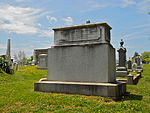Potomac Avenue station
1977 establishments in Washington, D.C.Capitol HillRailway stations in the United States opened in 1977Railway stations located underground in Washington, D.C.Stations on the Blue Line (Washington Metro) ... and 4 more
Stations on the Orange Line (Washington Metro)Stations on the Silver Line (Washington Metro)Use mdy dates from March 2018Washington Metro stations in Washington, D.C.

Potomac Avenue is an island-platformed Washington Metro station bordering the Barney Circle, Capitol Hill and Hill East neighborhoods of Southeast Washington, D.C., United States. The station was opened on July 1, 1977, and is operated by the Washington Metropolitan Area Transit Authority (WMATA). The station currently provides service for the Blue, Orange, and Silver Lines. The station serves a dense residential area of Southeast Washington around Potomac Avenue and is located at 14th and G Streets.
Excerpt from the Wikipedia article Potomac Avenue station (License: CC BY-SA 3.0, Authors, Images).Potomac Avenue station
Potomac Avenue Southeast, Washington
Geographical coordinates (GPS) Address Nearby Places Show on map
Geographical coordinates (GPS)
| Latitude | Longitude |
|---|---|
| N 38.880833333333 ° | E -76.985194444444 ° |
Address
Potomac Avenue Southeast 1412
20003 Washington
District of Columbia, United States
Open on Google Maps






